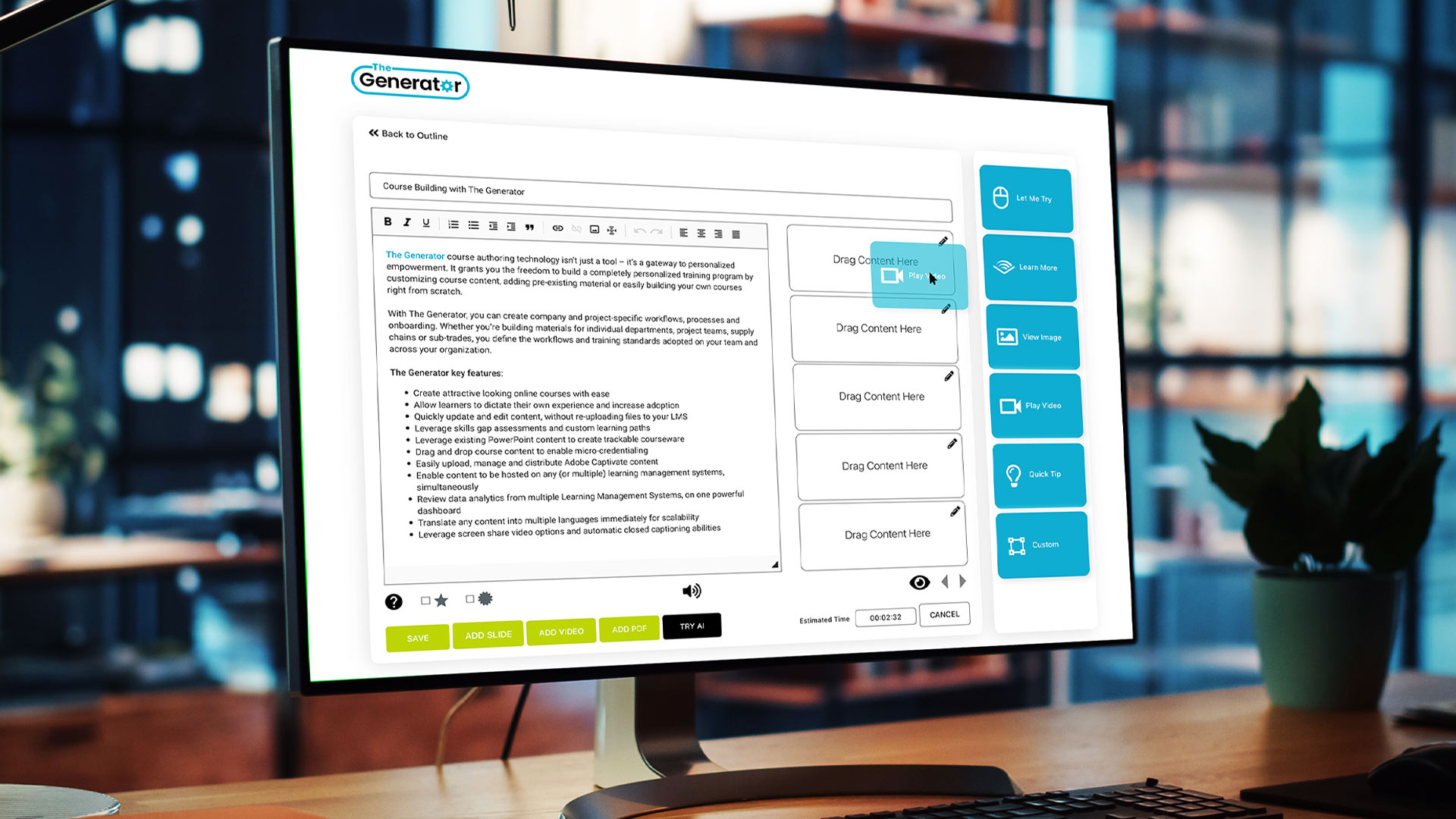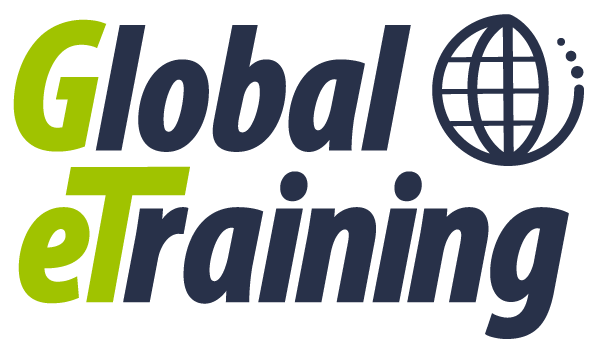
Executive Summary
Traditional online training development is time and cost intensive, often requiring 50 to 200+ hours to build one hour of interactive content (and in extreme cases far more).
As technology in AECO and manufacturing evolves rapidly, training content decays fast, making traditional refresh cycles inefficient.
The Generator from Global eTraining radically changes that model: using AI, version control, repurposing, built-in content libraries and context-aware search, it enables less than 10 hours of build time per new course.
The result: training placed directly into the hands of subject matter experts, faster iteration, always up to date content and full LMS integration with analytics.
In short, The Generator redefines how technical training is developed, deployed and maintained in fast-moving industries.
The Problem with Traditional eTraining Development
Time and Cost Overruns
The challenge is well documented. Estimates for building a single hour of interactive eTraining vary but all point to heavy investments of time and effort:
- According to Learning Experts / Christy Tucker, one hour of eTraining can take 40 to 160 hours depending on complexity.
- Chapman-Alliance / Articulate reference data show that a one-hour interactive eTraining course may average 197 hours of development (with low to high variance between 49 and 716 hours).
- Growth Engineering cites a development ratio of 184:1 (i.e. 184 development hours per 1 finished hour) for typical interactive content.
- Others point to wide ranges (50–700 hours) due to content complexity, media use, interactivity, stakeholder reviews and SME delays.
For simpler click-through slides, benchmarks of 1–2 hours per screen are common; for scenario branching or rich media the hours escalate fast.
In practice, development often slips further because:
- SMEs are slow to respond or supply technical content
- Revision cycles drag
- Integrations, QA, browser/device compatibility, accessibility checks and LMS packaging add hidden overhead
- Versioning and content updates require full rework
This is a drag on responsiveness, especially for industries where the domain knowledge (e.g. machinery specs, engineering norms, compliance, software versions) shifts fast.
Content Decay and Refresh Costs
Once built, a course starts decaying. By the time a major update is needed, costs for maintenance become high.
Updates may require returning to storyboards, remixing media, reconciling version control, re-testing across devices and again going through SME or approval cycles.
Traditional development models tend to underfund ongoing maintenance, meaning content becomes stale or lags behind current practices.
Barriers to Scalability
Because of the large build time and cost, organizations tend to:
- Limit training scope
- Batch large development runs (rather than incremental updates)
- Centralize control in L&D teams, creating bottlenecks
- Defer updates, accepting that content will trail reality
None of this is sustainable when your AECO or manufacturing environment is evolving continuously.
Introducing The Generator by Global eTraining
Design Philosophy and Core Capabilities
AI augmented authoring and repurposing
- Automatically ingest existing documents, slide decks, technical manuals, drawings and videos
- Use AI to chunk content, generate learning objective candidates, suggest module outlines and link contextual resources
- Reuse and remix content blocks across courses
Version control and module traceability built in
- Every module, asset and knowledge block is versioned
- Updates to source content can propagate selectively
- Branching versions for projects, geographies or regulations
Rich library of AEC and manufacturing technical content
- Thousands of hours of domain content (spec sheets, case studies, simulation modules) available
- Always kept up to date with evolving codes, tools and standards
Multilingual and contextual learning
- Built-in translation/localization (machine + human post edit
- Context-aware search lets learners search across modules, assets and past versions
Integration with any LMS or data export
- Output SCORM, xAPI, cmi5 or API based feeds
- Full analytics surfaced to L&D (completion, assessment, usage)
- Support for adaptive paths and modular sequencing
Empowering SMEs as content creators
- SMEs (engineers, technical leads) can directly author or remix modules
- Lightweight authoring UI with AI assistance and guardrails
- L&D’s role shifts from builder to curator and validator
Core Differentiators vs Traditional Tools
Feature | Traditional Development | The Generator |
Build Time for New Course | 50–200+ hours per hour of content | Less than 10 hours per course (for remixed or derivative) |
Freshness / Update Cycle | Slow, manual, risky | Incremental, versioned, live |
SME Involvement | Bottlenecked, indirect | Central, immediate, iterative |
Multilingual Support | Expensive external localization | Built-in translation workflow |
Integration and Analytics | Needs custom packaging or dev work | Native LMS export and analytics |
Technical Domain Scaling | Hard to reuse across engineering domains | Modular, reusable across AEC and manufacturing contexts |
Because your content base is domain rich and versioned, the marginal cost of creating a derivative or updated module is very low. That is how The Generator can deliver new or updated training in under 10 hours.
Quantifying the Time Savings
Let’s compare a hypothetical scenario:
Traditional build: You want a new course module for a technical system change. You start from scratch, scope, storyboard, acquire assets, develop interactions, test and revise. You incur perhaps 100 hours of development (a conservative mid-range figure) to deliver a 1 hour module.
With The Generator: You repurpose 70% of existing content blocks, run AI assisted adaptation, plug in changes, validate and export. You complete in under 10 hours.
This implies a 10x or greater reduction in development hours.
If your organization produces 20 such modules per year, the savings become significant:
At $100 per hour internal cost, traditional = 20 × 100 × $100 = $200,000
With The Generator = 20 × 10 × $100 = $20,000
Annual time saved: ~1,800 hours
ROI: platform cost + support vs content build cost differential
Additionally, because updates or version changes can be pushed rapidly, costs for maintenance and refresh drop dramatically.
Beyond sheer time, faster updates mean your training stays aligned with the latest equipment, build codes, methods or compliance standards. That agility yields business value in risk mitigation, performance and time to competency.
Use Cases in AECO and Manufacturing
- Equipment and System Upgrades
When machinery is upgraded or replaced, training must follow. With The Generator, only delta content needs rebuild — the rest is reused and versioned. - Code or Regulatory Changes
Building codes, safety standards and compliance rules change. A modular domain basis means updates propagate automatically, with SMEs validating new elements. - Onboarding and Cross-Discipline Familiarization
New recruits across civil, mechanical, electrical or process branches can be trained on overlapping modules (e.g. fundamentals, safety, standards) and tailored later. Reuse accelerates scale. - Project-based Custom Training
Each large project may need site or component specific modules. Start from a baseline, remix quickly and deliver site specific lessons in hours.
Implementation and Change Management
Organizational Shift
- L&D teams pivot from building to governance, quality and curation
- SMEs become co-creators; invest in light training and guardrails
- Culture must accept iterative updates rather than big launches
Governance, Quality and Validation
- Editorial workflows layered into authoring UI (review, version locks, SME sign off)
- Quality assurance (QA) pipelines embedded (automated checks, accessibility, consistency)
- Training audit trail is intrinsic
Pilot and Phased Rollout
- Start with one domain (e.g. structural systems or a specific product)
- Track time, feedback, performance metrics and compare to legacy development
- Expand to adjacent modules and domains
Training and Support
- Train SMEs and L&D on authoring UX, AI assisted editing, ORM (object reuse management)
- Provide a playground to experiment with remixing content
Risks and Mitigations
Risk | Mitigation |
SME adoption resistance | Provide UI ease, templates, training and initial support |
Overreliance on AI (quality, hallucination) | Human in the loop validation, guardrails, version rollback |
Incomplete coverage of legacy content | Initial migration and content cleanup phase |
Version conflicts or merge issues | Strong version control, module lock and branch features |
Integration mismatches with LMS | Extensive export format support, API connectivity, custom adapters |
Summary and Call to Action
Traditional eTraining development is expensive, slow and ill-suited to industries where technology, compliance and engineering practices evolve quickly. The Generator flips that paradigm:
- Build or update training in less than 10 hours
- Keep content always current, versioned, localized
- Empower SMEs to own knowledge delivery
- Equip L&D with analytics, oversight and governance
- Scale technical training across AEC and manufacturing with agility
